#1926 international exposition
Explore tagged Tumblr posts
Text

America Welcomes the World. Sesquicentennial International Exposition Philadelphia poster - 1926.
#the 20s#the 1920s#20s fashion#20s style#posters#vintage posters#vintage illustration#sesquicentennial international exposition philadelphia#1926 philadelphia exposition#1926 international exposition#philadelphia exposition
3 notes
·
View notes
Text

The 1926 International Exposition of Hairdressing and Beauty Culture in Toronto shows off the latest in attire an coiffures. Mole Lorraine Johnston displays her elongated headdress.Photo by John Boyd.
5 notes
·
View notes
Text
Ettore Tito (17 December 1859 – 26 June 1941) was an Italian artist particularly known for his paintings of contemporary life and landscapes in Venice and the surrounding region. He trained at the Accademia di Belle Arti in Venice and from 1894 to 1927 was the Professor of Painting there. Tito exhibited widely and was awarded the Grand Prize in painting at the 1915 Panama–Pacific International Exposition in San Francisco. In 1926 he was made a member of the Royal Academy of Italy. Tito was born in Castellammare di Stabia in the province of Naples and died in Venice, the city which was his home for most of his life.
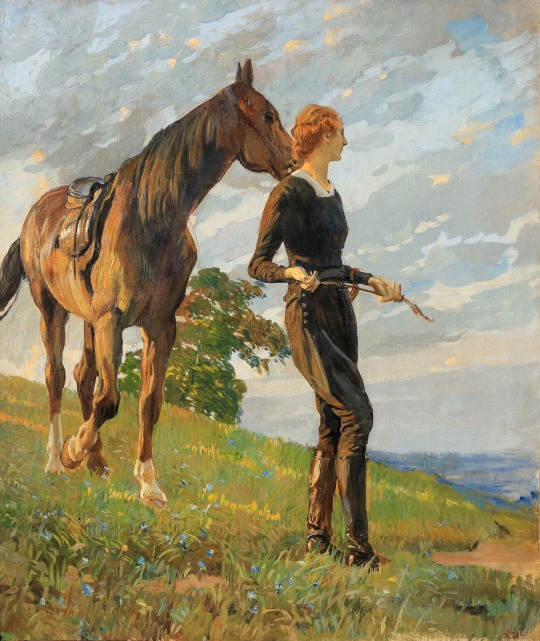
Ettore Tito - The meeting (ca. 1930-35)
481 notes
·
View notes
Photo
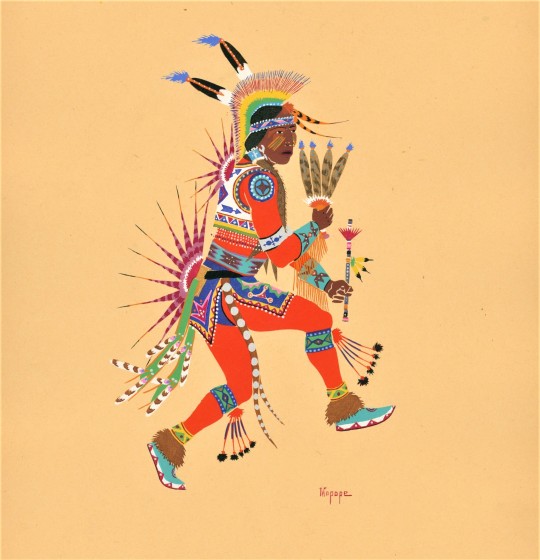
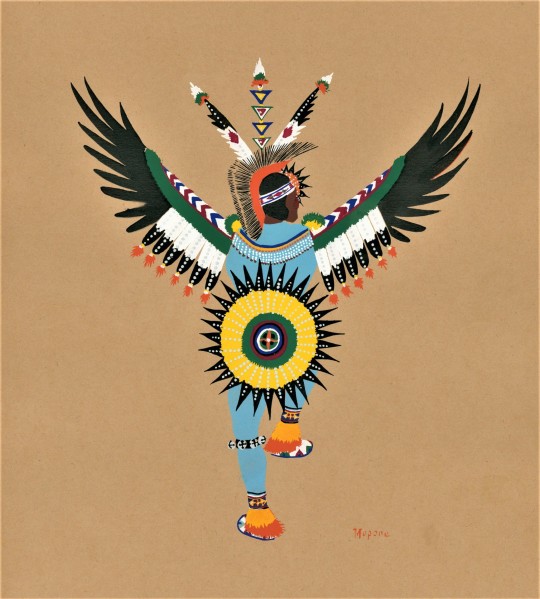
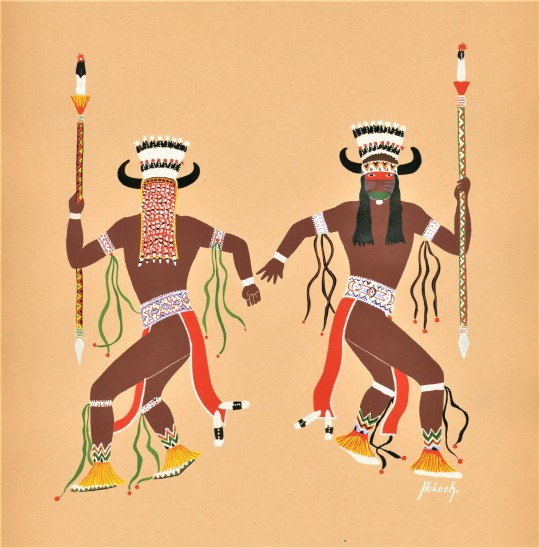

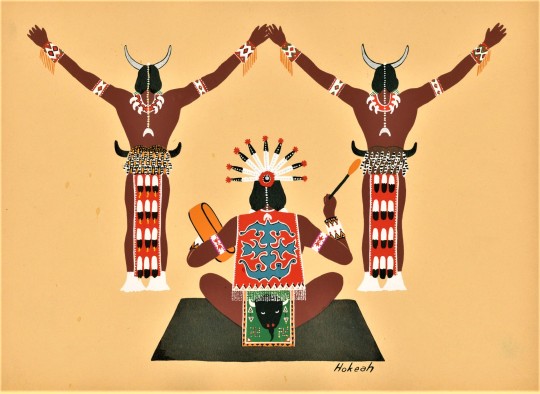


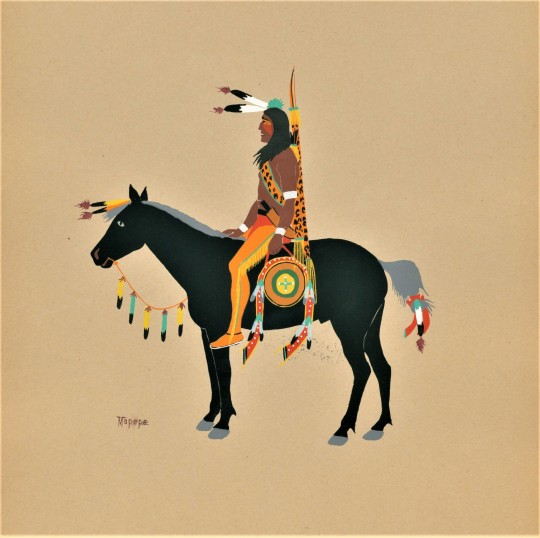
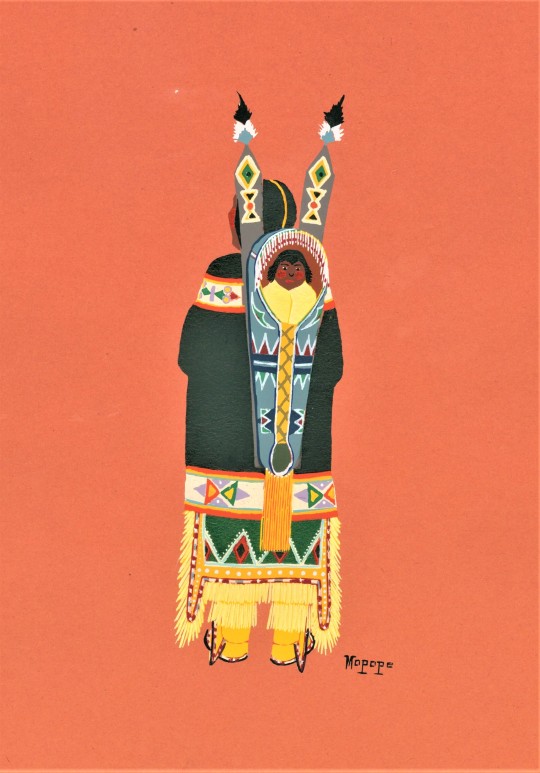
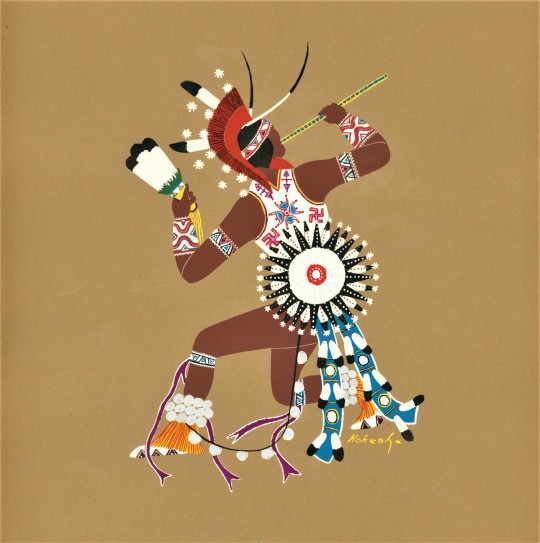
Decorative Sunday
The Nice, France-based decorative arts publisher C. Szwedzicki produced six titles on Native American Art. We’ve already presented their 2-volume portfolio Pueblo Indian Pottery, published from 1933-1936. This week we present some plates from the first of the six titles, Kiowa Indian Art, with images from the collection of Swedish-born American painter and Native American art curator Oscar Brousse Jacobson, published in 1929 in an edition of 750 copies signed by the publisher. The portfolio includes 30 color plates reproducing the paintings of the so-called Kiowa Six: Spencer Asah, James Auchiah, Jack Hokeah, Stephen Mopope, Monroe Tsatoke and Lois Smoky. The images shown here are by Asah, Hokeah, Mopope, and Smoky. Click on the images to see the attributions.
Oscar Jacobson was director of the University of Oklahoma's art department and established a special program at the school in 1926 for these promising Kiowa artists. They were provided with studio space, painting instruction, and choice exhibition venues, including the 1928 First International Art Exposition in Prague where they received international acclaim. This portfolio was produced soon after. The work of the Kiowa Six are considered significant in the development of Native American painting by bridging the era of Ledger Art to flat-style Southern Plains painting. Of the six, the work of Lois Smoky is the rarest and the most collectable as she left the program in 1927 and did not continue painting, although she later became noted as an accomplished beadworker.
View more posts on works published by C. Szwedzicki.
View other Decorative Sunday posts.
#Decorative Sunday#decorative arts#decorative plates#C. Szwedzicki#Kiowa Indian Art#Kiowa artists#Kiowa Six#Spencer Asah#James Auchiah#Jack Hokeah#Stephen Mopope#Monroe Tsatoke#Lois Smoky#Oscar Brousse Jacobson#Oscar Jacobson#Native Americans#Native American art#Native American artists
141 notes
·
View notes
Text
27 chairs | part 1/3
A short collection of iconic chairs, in chronological order.

Charles Rennie Mackintosh, Hill House Chair, 1902 Decorative chair specifically designed for the bedroom of the Hill House (Charles and Margaret Machintosh; Helensburgh, Scotland, 1904). The chair, made of solid ash wood, painted in black, was inspired by Japanese craft and the grid on the top became Mackintosh’s design signature.
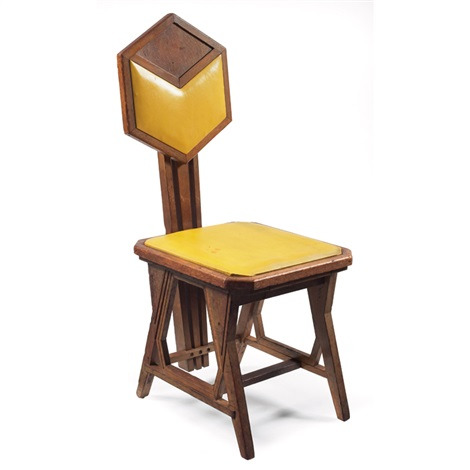
Frank Lloyd Wright, Peacock Chair, 1921 Oak side chair used throughout the Imperial Hotel (Frank Lloyd Wright; Tokyo, Japan, 1923).
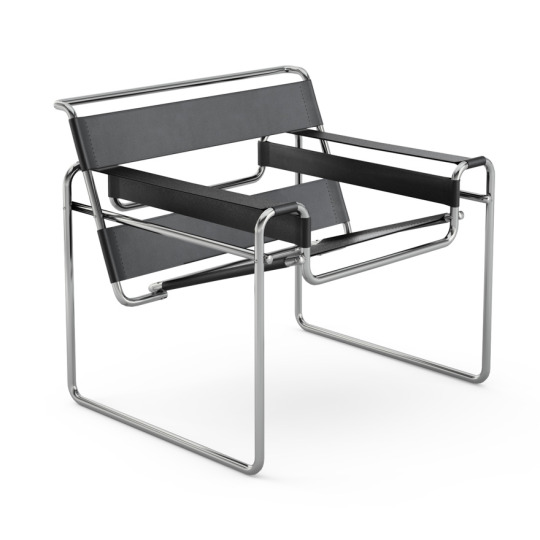
Marcel Breuer & Marcel Bouvier, Wassily Chair, 1925 Armchair manufactured by Thonet, a German-Austrian company. Its bent steel tube frame, inspired by bicycles construction, and taut Eisengarn fabric revolutionized the furniture industry because of their materials, manufacturing process and aesthetics.
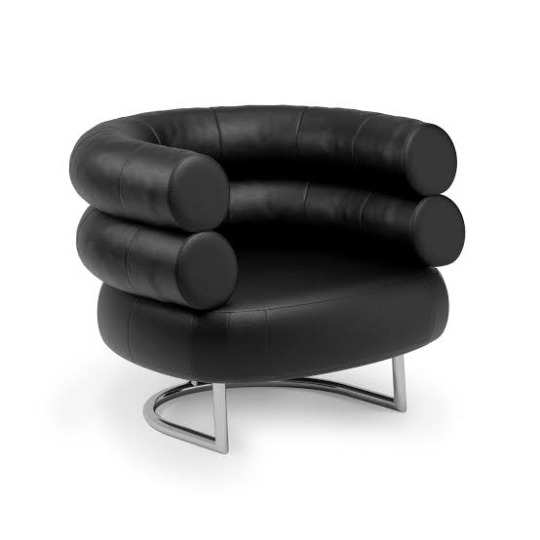
Eileen Gray, Bibendum, 1926 Tubular steel and leather armchair, inspired by the “Bibendum” Michelin Man and presented as a playful “feminist” response to Le Corbusier’s Grand Confort armchair.

Marcel Breuer, Cesca Chair, 1928 Breuer chose again the tubular steel bending technology used in bicycles, in order to achieve standardization and mass production. It was combined with wooven cane and beech wood and became one of the most common chairs of the XXth century.

Lilly Reich & Ludwig Mies Van Der Rohe, Barcelona Chair, 1929 Designed for the German Pavillion at the International Exposition of 1929 (Mies Van Der Rohe; Barcelona, Spain; 1929) for the Spanish royalty to oversee the ceremony.

Alvar Aalto, Chair 69, 1935 The chair resulted from experiments with solid bent wood which helped create the L-shape, seen on the legs of the chair and applied to a series of other pieces of the same collection. The chair’s structure is made of solid Finnish birch.

Antoni Bonet & Juan Kurchan & Jorge Ferrari Hardoy, BKF Chair, 1938 A chair consisting of thin folded iron bars and a leather seat, which allows for various relaxed sitting position. The chair became an icon of Argentine design.

Eero Saarinen, Tulip Chair, 1956 A plastic chair designed for the Knoll company as part of the Pedestal Collection, which explored plastic furniture, devoid of the traditional legs.
#furniture#1900s#1920s#1930s#1950s#charles rennie mackintosh#frank lloyd wright#marcel breuer#marcel bouvier#eileen gray#lilly reich#mies van der rohe#alvar aalto#antoni bonet#juan kurchan#jorge ferrari hardoy#eero saarinen
16 notes
·
View notes
Photo

1926 'America Welcomes the World' The Sesquicentennial International Exposition Philadelphia
Source: Pinterest / fabienne jerot
Published at: https://propadv.com/travel-poster-and-ad-collection/usa-travel-poster-and-ad-collection/
6 notes
·
View notes
Text
Help This Scholar Reverse the Erasure of Native Contributions in the Creation of These 20th-Century Murals
https://sciencespies.com/history/help-this-scholar-reverse-the-erasure-of-native-contributions-in-the-creation-of-these-20th-century-murals/
Help This Scholar Reverse the Erasure of Native Contributions in the Creation of These 20th-Century Murals

Smithsonian Voices Smithsonian Institution Office of Fellowships and Internships
Reversing the Erasure of Native Contributions to Muralism
October 9th, 2020, 9:00AM / BY
Davida Fernandez-Barkan

Eduard Buk Ulreich, Advance Guard of the West (mural study, New Rockford, North Dakota Post Office), ca. 1939-1940, tempera on fiberboard, Smithsonian American Art Museum, Transfer from the U.S. Department of the Interior, National Park Service, 1965.18.33
Being an art historian is a little like being a detective. It sometimes takes me to unlikely places—including, recently, a basement outside St. Louis, where the relatives of an artist I was researching for my dissertation generously allowed me to review documents from his life. The artist, Eduard “Buk” Ulreich, had designed a number of publicly funded murals throughout his career; studies for many of them can be found in the collection of the Smithsonian American Art Museum and Renwick Gallery (SAAM). My interest in Ulreich was related to two 88-foot wooden panels inspired by Native American symbols that he conceived for the United States Pavilion at the 1937 World’s Fair in Paris.[1] One document in particular has occupied my thoughts in the months since my visit: a newspaper clipping showing two men shaking hands. The men stand in front of what appears to be Ulreich’s mural Indians Watching Stagecoach in the Distance (1937), which he painted for the post office in Columbia, MO. The man on the left is named in the caption as the 1937 U.S. pavilion’s “chief designer,” Paul Lester Wiener, while the one on the right, appearing in a feathered headdress, is identified simply as, “a Navajo Indian who gave his advice on the vast murals depicting Indian life and thought which are being painted by Buck [sic.] Ulreich for the outside of the skyscraper tower.”[2] My goal, ultimately, is to identify this man. Yet even without declaring this man’s identity, the photograph highlights an oft-overlooked aspect of twentieth-century American art: the essential contributions of Native Americans to the mural movement that overtook the United States in the years between World War I and World War II.

Paul Lester Wiener and an unidentified advisor for the U.S. Pavilion murals, Private archive of Eduard “Buk” Ulreich, St. Louis, MO. (Hans Knopf, Pix, Inc.)
Ulreich was one of the many U.S. artists who received funds to install murals in public buildings in the United States during the 1930s and early 1940s through programs such as the Public Works of Art Project, the Treasury Section of Fine Arts, and the Works Progress Administration. He styled himself as a “Cowboy-Painter,” a claim that lay in part in his avowed knowledge of Native American cultures.[3] The artist was vocal about time he had spent around Native Americans, including as an actual cowboy on a ranch on an Apache reservation in Arizona. He posited that it was this type of exposure that resulted in his selection to paint the exposition murals.[4] Yet as the newspaper clipping indicates, Ulreich required the input of at least one Native advisor to accurately convey the mural’s symbols. A different clipping in Ulreich’s family’s archive identifies a number of the symbols that appear, stacked on top of one another, in the pavilion’s murals. These include a “Kachina”[5] figure popular in Pueblo cultures, a Crow thunderbird, and an adaptation of a deity used in Navajo[6] sand painting.[7] This same clipping indicates that, although Ulreich designed the murals, a “member of the Navajo tribe” actually painted them. This individual, like the man in the photograph, is unnamed in the clippings. Neither appears to be mentioned at all in fair-sponsored publications and they are absent altogether from what limited secondary literature exists about the U.S. pavilion at the 1937 exposition.
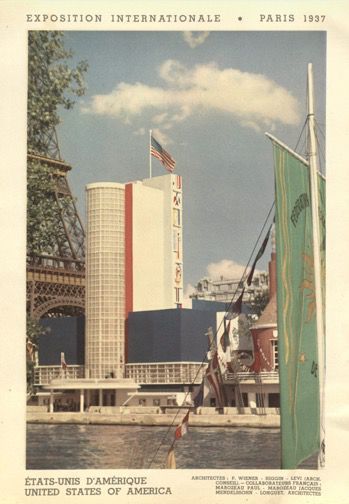
The U.S. Pavilion at the 1937 World’s Fair in Paris, pylon murals designed by Eduard “Buk” Ulreich, from Photographies en couleurs: exposition internationale des arts et des techniques appliqués à la vie moderne: album official (Paris: Photolith, 1937)
The 1937 fair was not the first world’s fair to feature murals indebted to Native American labor and knowledge. The 1933 Century of Progress exposition in Chicago had included a series of murals executed by a group of artists associated with the Santa Fe Indian School. Changing perceptions of Native culture, reflected in the work of both Native and non-Native artists alike, were in fact a hallmark of the mural movement in the United States. In addition, one of the movement’s most revolutionary aspects was an increased access to the role of “artist.” Not only men of European descent, but also many women, Native Americans, and other people of color became muralists. Still, artists from these marginalized groups did not receive the same treatment as their white male counterparts. Like the Native participants in the 1937 exposition, the artists who developed the Century of Progress murals are anonymous in fair literature. One administrative document refers to them simply as the “Santa Fe Indians,” while it refers to white artists such as George Biddle and John Norton by name.[8] Thanks to the work of art historians such as Jennifer McLerran, we know the identities of many of the mural artists involved with the Santa Fe Indian School. Several of these are represented in SAAM’s collection, including Julian “Pocano” Martinez, Tse Ye Mu (known alternately as Romando Vigil), Awa Tsireh (known alternately as Alfonso Roybal), Oqwa Pi (known alternately as Abel Sanchez), and Ma Pe Wi (known alternately as Velino Shije Herrera), whose murals can also be found in the Department of the Interior building in Washington, D.C.[9]
To identify the Native individuals who helped create the panels at the 1937 fair would ensure that they are given credit, if belated, for their work. Beyond this, it would be a means of celebrating Native contributions to the mural movement. Native participation in the painting of such monumental, public works of art during this period is little known and seldom discussed, a problem that is compounded when we do not know the names of the individuals who took part. The erasure of nonwhite groups from public life is particularly dangerous, as it has a pernicious history in this country. From attacks on Black communities to anti-immigrant rhetoric, the claim that only white Americans “create,” while others sponge off their productivity, has been one of the most insidious myths shoring up the ideology of white supremacy over the last several centuries.[10]
Searching for the identity of the man in the 1937 photograph is a small way of combatting this myth. It is a way of ensuring that white artists do not receive the only credit for their collaborations with communities of color. I am therefore hoping that anyone who might have information about the man in the photograph or other Native participants in the 1937 exposition will get in touch! With such interventions, perhaps art history can help to make the inclusiveness promised by muralism a reality.
[1] Carlyle Burrows, “A New Project in Modern Decoration: The Stage Coach and the Pony Express,” New York Herald Tribune, August 1, 1937, F6.
[2] Art historian Emily Burns notes that the man’s dress appears to be a composite of clothing from a number of different Native nations. The headdress, for example, is typical of Plains rather than southwestern cultures. It thus constitutes a kind of Native American “intern-nationalism” against the backdrop of the International Exposition. Emily Burns, email message to the author, September 30, 2020.
[3] “With Latin Quarter Folk,” Folder “1926,” Private Archive of Eduard “Buk” Ulreich, St. Louis, MO.
[4] Eduard “Buk” Ulreich, “Eduard Buk Ulreich: A Brief History,” n.d., Folder “Buk Autobiography,” Private Archive of Eduard “Buk” Ulreich, St. Louis, MO; “Story of the Indian Ornament for the American Exposition Building at Paris, France,” n.d., Folder “1937,” Private Archive of Eduard “Buk” Ulreich, St. Louis, MO.
[5] The term “katsina” (plural “katsinam”) is preferred.
[6] Members often prefer the name “Diné” to Navajo.
[7] Francis Smith, “Brilliant Murals Portray Lore of U.S. Indains at Exposition,” Paris Herald, July 27, 1937, Private Archive of Eduard “Buk” Ulreich, St. Louis, MO.
[8] “Interior Painting & Murals,” n.d., Series 15, Box 7, Folder 15-74, Century of Progress World’s Fair, 1933-1934 (University of Illinois at Chicago).
[9] See Jennifer McLerran, A New Deal for Native Art: Indian Arts and Federal Policy, 1933-1943 (Tucson: University of Arizona Press, 2012), 164.

Davida Fernandez-Barkan is a Ph.D. candidate in History of Art and Architecture at Harvard University and was a Smithsonian Institution Predoctoral Fellow at the Smithsonian American Art Museum during the 2019–20 academic year. She holds an A.B. and M.A. in History of Art and Architecture from Harvard and an M.A. in Curating the Art Museum from The Courtauld Institute of Art. She has worked or interned in curatorial departments at the Harvard Art Museums, the Centre Georges Pompidou, the Institute of Contemporary Art/Boston, the National Gallery of Art, Tate Britain, and the Hirshhorn Museum and Sculpture Garden. Her work appeared in the most recent issue of the journal Public Art Dialogue. Her dissertation is titled, “Mural Diplomacy: Mexico, the United States, and France at the 1937 International Exposition in Paris.” She is currently a Center for Advanced Study in the Visual Arts (CASVA) David E. Finley Fellow (2020–23).
More From This Author »
#History
1 note
·
View note
Text
INTRODUCTION TO BARCLEONA

The Casa de les Punxes or Casa Terradas, designed by Josep Puig i Cadafalch.

Casa Batlló - in the center of Barcelona. Designed by Antoni Gaudí. It is considered one of his masterpieces. A remodel of a previously built house, it was redesigned in 1904 by Gaudí and has been refurbished several times after that. The local name for the building is Casa dels ossos (House of Bones), as it has a visceral, skeletal organic quality.

Plaça Catalunya - The plaza occupies an area of about 50,000 square metres. It is especially known for its fountains and statues, its proximity to some of Barcelona's most popular attractions, and the flocks of pigeons that gather in the centre.

La Rambla - is a street in central Barcelona. A tree-lined pedestrian street, it stretches for 1.2 kilometres connecting Plaça de Catalunya in the centre with the Christopher Columbus Monument at Port Vell.
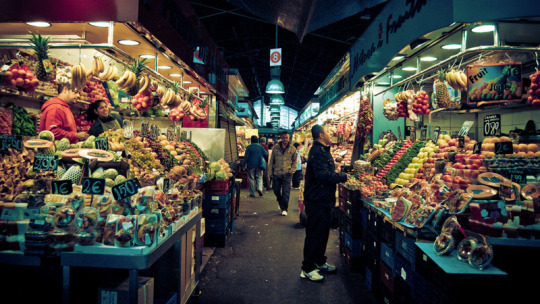
La Boqueria food market - is a large public market in the Ciudad Vieja district of Barcelona, Catalonia, Spain, and one of the city's foremost tourist landmarks, with an entrance from La Rambla, not far from the Liceo, Barcelona's opera house.

Gothic Quarter - The charming Gothic Quarter, or Barri Gòtic, has narrow medieval streets filled with trendy bars, clubs and Catalan restaurants. The Museu d'Història de Barcelona shows remains of the Roman city. Artisans sell leather and jewellery near the Cathedral of Barcelona, while flower stalls and street-food vendors line busy avenue La Rambla. The Plaça del Pi, named after the adjacent Gothic church, hosts a weekend art market.
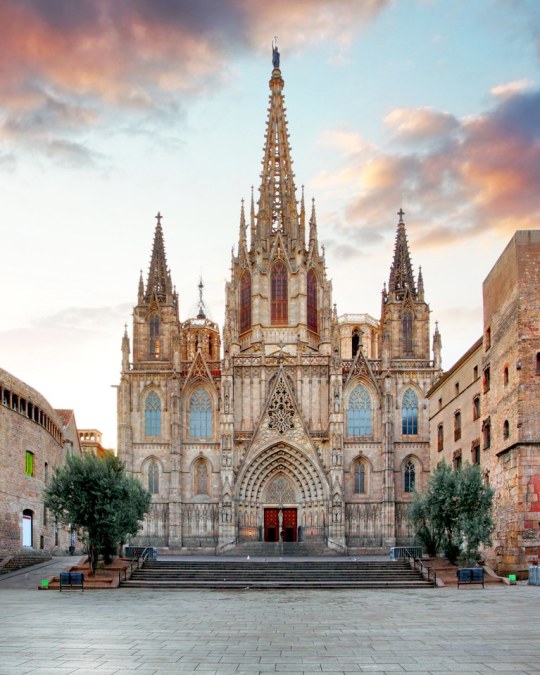
Barcelona Cathedral - The Cathedral of the Holy Cross and Saint Eulalia, also known as Barcelona Cathedral, is the Gothic cathedral and seat of the Archbishop of Barcelona, Catalonia, Spain. The cathedral was constructed from the thirteenth to fifteenth centuries, with the principal work done in the fourteenth century.

Basilica of Santa Maria del Mar - is a church in the Ribera district of Barcelona, Spain, built between 1329 and 1383 at the height of Principality of Catalonia's maritime and mercantile preeminence. It is an outstanding example of Catalan Gothic, with a purity and unity of style that is very unusual in large medieval buildings.
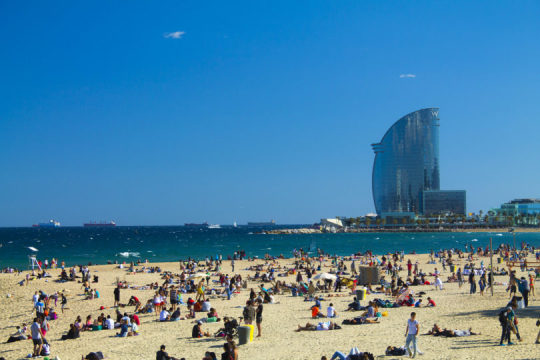
Beach

Park Güell - is a public park system composed of gardens and architectonic elements located on Carmel Hill, in Barcelona, Catalonia, Spain. Park Güell is the reflection of Gaudí's artistic plenitude, which belongs to his naturalist phase. During this period, the architect perfected his personal style through inspiration from organic shapes.
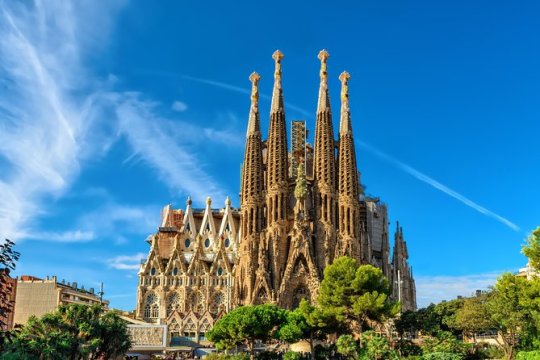


La Sagrada Familia - is a large unfinished Roman Catholic minor basilica in Barcelona, Catalonia, Spain. Designed by Catalan architect Antoni Gaudí. On 19 March 1882, construction of the Sagrada Família began under architect Francisco de Paula del Villar. In 1883, when Villar resigned, Gaudí took over as chief architect, transforming the project with his architectural and engineering style, combining Gothic and curvilinear Art Nouveau forms.
Gaudí devoted the remainder of his life to the project, and he is buried in the crypt. At the time of his death in 1926, less than a quarter of the project was complete. Relying solely on private donations, the Sagrada Família's construction progressed slowly and was interrupted by the Spanish Civil War. In July 1936, revolutionaries set fire to the crypt and broke their way into the workshop, partially destroying Gaudí's original plans, drawings and plaster models, which led to 16 years work to piece together the fragments of the master model.

Casa Milà - popularly known as La Pedrera or "The stone quarry", a reference to its unconventional rough-hewn appearance, is a modernist building. It was the last private residence designed by architect Antoni Gaudí and was built between 1906 and 1912. The building was commissioned in 1906 by Pere Milà [ca; es] and his wife Roser Segimon [ca; es]. At the time, it was controversial because of its undulating stone facade, twisting wrought iron balconies and designed by Josep Maria Jujol. Several structural innovations include a self-supporting stone façade, and a free-plan floor, underground garage and the spectacular terrace on the roof.

Fundació Joan Miró - is a museum of modern art honoring Joan Miró. His connection to the land and his interest in everyday objects and in the natural environment formed the backdrop to some of his technical and formal research. Self-contained in his manners and public expressions, it is through art that Joan Miró showed his rebelliousness and a strong sensitivity to the political and social events around him.
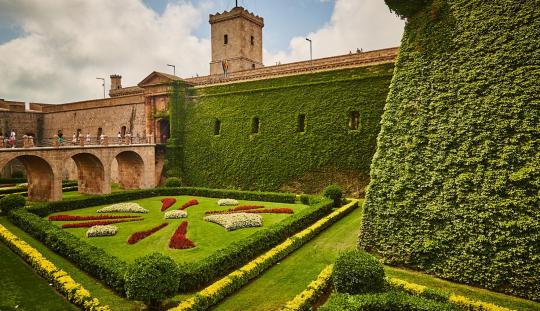
Montjuïc Castle - is an old military fortress, with roots dating back from 1640. In the last 350 years Montjuïc Castle has played a decisive role in the history of Barcelona, becoming a symbol after the Catalan defeat to Spain in 1714. Since then the Montjuïc cannons have bombarded the city and its citizens on various occasions, and Montjuïc has been used as a prison and torture centre repeatedly for three centuries.The castle is infamous in Catalan history books because of its role in the civil war from 1936 to 1939 when both sides of the conflict imprisoned, tortured and shot political prisoners at Montjuïc, among them Lluís Companys, who was the president of the Generalitat of Catalonia during the Spanish Civil War. Companys was executed upon orders from the Spanish State at Montjuïc Castle in 1940.

Barcelona Pavilion - designed by Ludwig Mies van der Rohe and Lilly Reich, was the German Pavilion for the 1929 International Exposition in Barcelona, Spain. The pavilion for the International Exhibition was supposed to represent the new Weimar Germany: democratic, culturally progressive, prospering, and thoroughly pacifist; a self-portrait through architecture.

Jardí Botànic de Barcelona (Botanic Garden) - set amongst a number of stadiums used in the Summer Olympic Games of 1992. Although a botanical garden had been established in Barcelona as early as 1888, the current gardens date from 1999. “After only a few minutes of walking around the Botanic Gardens I felt I had entered a Zen monastery, calm and peace and cleanliness.”

Bibliotec Sant Antoni (Joan Oliver) - The library, named in honor of playwright and poet Joan Oliver, came about through a competition won by RCR in 2005. The architects sought to make the street more dynamic and to open up the inner courtyard for public use, as well as to create a library. The glass-enclosed main reading room is raised up and set between the two lateral wings of the library, which allow light to filter through from both sides, forming a gateway into the public space. This courtyard, with its trees, earthen paving, sitting areas, games, etc. can be understood as an extension of the library’s reading rooms.
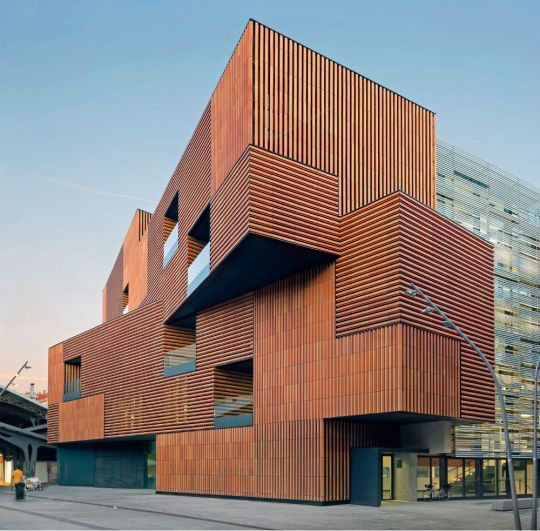
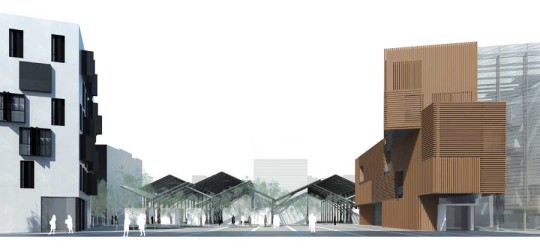
Plaza de la Gardunya - Escuela Massana (school of Art and Design) is part of the long process of urban transformation of Plaza de la Gardunya, located in Barcelona’s historical centre. the effort put into this project responds to the desire of creating a bright interior space with open connecting spaces whilst, at the same time, the exterior of the building remains in harmony with the urban fabric. The building showcases different volumetries and façade textures as a response to the surrounding buildings. With the aim of giving it a more unique and sculptural look and, at the same time, make it more airy, the section that faces onto the square is divided into two sections slightly rotated, creating terraces. The school, which is an institution that welcomes future artisans and designers, is clad in a ceramic material of large dimensions, made in an artisanal manner and unique to our building. This helped to give it its unique character and highlights the sculptural nature of the building, whilst protecting the privacy of the students.
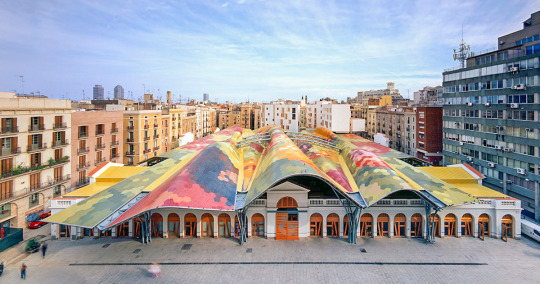
Santa Caterina Food Market - Buzzy market featuring a unique, wavy roof & colourful mosaics, with a variety of vendors & eateries. A competition was opened to restore the Santa Caterina city market located in the old quarter of Barcelona in 1997. EMBT won the bid with a proposal that aimed at incorporating the extreme complexity of the setting itself by creating a commercial market complemented by a residential zone and public spaces that integrated all the activities of the neighbourhood.
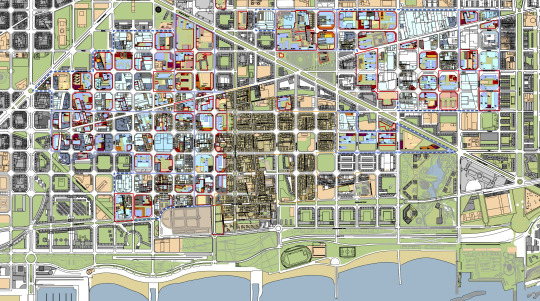
22@ District - is the corporative name given to an urban renewal area in Barcelona's formerly industrial area of Poblenou, in the district of Sant Martí, nicknamed "the Catalan Manchester" in the 19th century. Its aim is to convert Poblenou into the city's technological and innovation district, as well as to increase leisure and residential spaces. Centered on Plaça de les Glòries Catalanes, it is part of one of Europe's biggest urban regeneration schemes, begun during the 2000s and still ongoing.

The Museu del Disseny de Barcelona - is a new center of Barcelona's Institute of Culture, acting as a museum and laboratory. It focuses on 4 branches or design disciplines: space design, product design, information design and fashion. Barcelona is a city historically linked to design. It was decided to build a single space in which locate all collections and endowments existing in Barcelona related to the world of design, and Oriol Bohigas commissioned the construction of a building in the Plaça de les Glòries.

Torre Glòries - is a 38-story skyscraper which marks the gateway to the new technological district of Barcelona. It was designed by French architect Jean Nouvel in association with the Spanish firm b720 Fermín Vázquez Arquitectos and built by Dragados. Torre Agbar is intended to recall the shape of a geyser rising into the air. It was inspired by Montserrat, a mountain near Barcelona. In an interview, he described the tower as having a phallic character.

Edifici Mediatic - Enric Ruiz-Geli doesn’t emphasise the media impact of his futuristic building, but instead its energy efficiency. Extensive studies formed the basis for the parametric design where the award-winning steel frame is on the outside and the interior offers flexible use of space. The patented cushions made of ETFE membranes are controllable, allowing the different façades to be insulated, opened, or shaded as needed. Edifici MediaTIC is a prime example of forward-looking architecture.
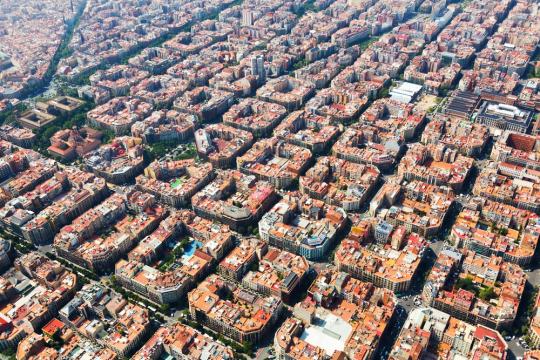
Urban Superblocks - Barcelona’s radical plan to take back streets from cars. A vision for a different way of living in the 21st century, one that steps back from many of the mistakes of the auto-besotted 20th century, refocusing on health and community. It is a bigger and more ambitious city plan than anything being discussed in America and, more important, a plan that is actually being implemented, with a few solid pilot projects behind it, a list of lessons learned, and a half-dozen new projects in the works.
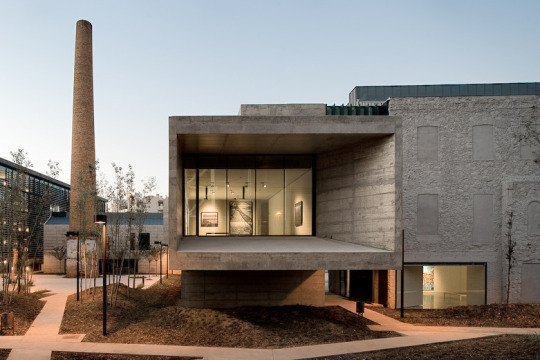
Can Framis Museum - Is an art center devoted to the promotion of contemporary Catalan painting. Located in the old Can Framis factory complex, the museum displays more than 250 paintings from the sixties to the present made by artists born or currently living in Catalonia.
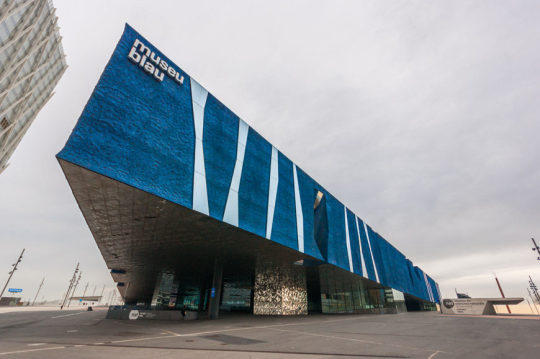
Museu Blau (Science Museum) – By Herzon De Meuron “We look for materials which are as intelligent, versatile and complex as natural phenomena, in other words materials which don't just appeal to the eyes of the astounded art critic, but are also really efficient and appeal to all our senses.” – Jacques Herzog. A triangular mass of gray-blue concrete punctured and split in places to reveal the contrasting use of reflective planes.
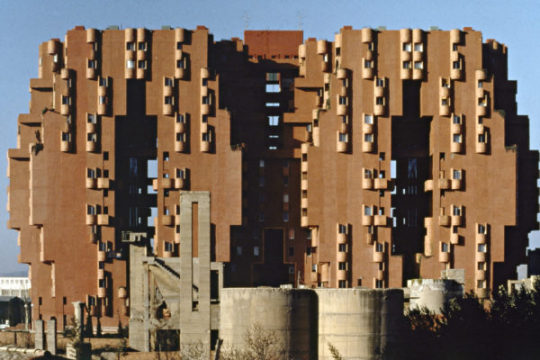

Walden 7 - is an apartment building designed by Ricardo Bofill's team and located close to Barcelona, in Catalonia. It was built in 1975. The original project includes 446 residences. The original exterior façade was covered with small, red ceramic tiles backed with the wrong adhesive, creating a pedestrian hazard as the tiles fell off the building.

The day of the Dead - is a Mexican holiday celebrated throughout Mexico, and by people of Mexican heritage elsewhere. The holiday involves family and friends gathering to pray for and remember friends and family members who have died, and helping support their spiritual journey. In Mexican culture, death is viewed as a natural part of the human cycle. Mexicans view it not as a day of sadness but as a day of celebration because their loved ones awake and celebrate with them. Mexican cempasúchil (marigold) is the traditional flower used to honor the dead.

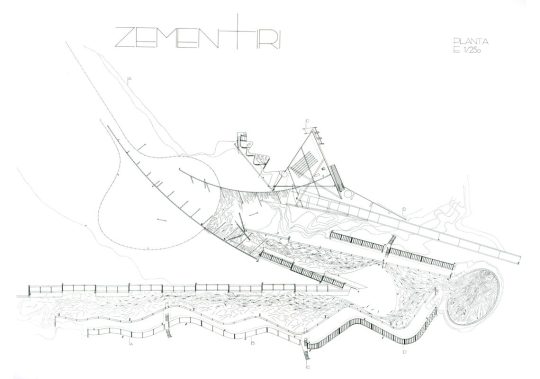
Igualada Cemetery - Designed by the architects Enric Miralles and Carme Pinós after winning an architectural competition in 1984. the cemetery became widely regarded as one of the most poetic works of twentieth century Catalan architecture. to explore poetic ideas regarding the acceptance of the cycle of life to enable a link between the past, the present, and the future. A processional "street" descends from the entrance, where crossed, rusting, steel poles doubling as gates and likened to the crosses at Calvary, proclaim the start of a winding pathway towards the burial area. The route is lined with repeatable concrete loculi forming retaining walls and the floor of the path has railway sleepers set into its concrete surface.The intention was to bring the bereaved down into the landscape to a 'city of the dead', an in between place where the dead and the living are brought closer together. The spaces are designed to provoke thoughts and memories.
5 notes
·
View notes
Text
A New Form for a New Technology
Danish architect and designer Poul Henningsen’s interest in light and lighting started at a young age when as a child in the 1900s, he observed the sharp glare from fixtures housing bare electric bulbs in his family home. Electric lighting was new, and older lighting devices, such as candlesticks or gas lamps, were being adapted for the new technology. The electric lamp had not yet achieved its own form.
By the early 1920s, when Henningsen was a practicing architect in Copenhagen, his interests included the challenge of designing electric lamps that would reduce glare and direct light where it was needed. He studied light diffusion and dispersal, experimenting with the size, shape and arrangement of reflectors, finally showing lamp prototypes in a 1924 Louis Poulson & Co. lighting competition for the Danish Pavilion at the 1925 Paris Exposition. His series of hanging lamps and table lamps won, and went on to garner gold medals in Paris. By 1926, Poulson had hired Henningsen and began production of the first PH lamps for use in a new exhibition hall in Copenhagen. The highly functional PH lamp series went on to achieve international attention.
The translucent milky white glass reflectors of this model PH 4/3 lamp by Henningsen, both diffuse and direct light while hiding the glare of the bulb itself. Henningsen’s design pares the electric lamp down to its simplest elements, to create a series of shapes accentuated by light and contrasting color. Three curved, circular reflectors are stacked, largest to smallest, atop a simple rod-like base on a flat circular foot of dark patinated metal. The socket is stamped “PAT. APPL.”, indicating that this example is an early production, manufactured before May, 1928, when the PH lamp was patented.
Cynthia Trope is Associate Curator of Product Design and Decorative Arts
from Cooper Hewitt, Smithsonian Design Museum http://bit.ly/2WmV3Xk via IFTTT
9 notes
·
View notes
Photo


Exposition Art Blog William Ronald - Canadian Abstract Painter
"William Ronald, Canadian painter (born Aug. 13, 1926, Stratford, Ont.—died Feb. 9, 1998, Barrie, Ont.), was the driving force behind the formation in 1953 of Painters Eleven, a group that introduced abstraction to Canadian art. Ronald studied with Jock Macdonald at the Ontario College of Art in 1951 before briefly attending Hans Hofmann’s school in New York City the following year. Ronald embraced the contemporary, international style of Abstract Expressionism, and his monumental canvases were a striking departure from the then-prevailing approach of the Group of Seven, who painted folkloric subjects featuring Canadian themes in an earnest, traditional manner."
More
#William Ronald#canadian painter#canadian art#artist#painting#art#artistic#abstract art#abstract painting#abstract expressionism#contemporary art#visual art#culture#art blog#exposition art blog
12 notes
·
View notes
Text
Frise chronologique :
1917 Guillaume Apollinaire utilise pour la première fois le mot surréaliste. Les artistes André Breton et Louis Aragon se rencontrent
1919 Mars : La revue Littérature qui est dirigée par André Breton, Philippe Soupault et Louis Aragon publie sont premier numéro Mai : L'écriture automatique est née des mains d'André Breton et Philippe Soupault lorsqu'ils rédigent Les Champs magnétiques.
1920 17 janvier : L'artiste Tristan Tzara débarque à Paris. 23 janvier : Le Palais des fêtes à Paris fait son premier Vendredi de Littérature 30 mai : Publication des Champs magnétiques au Sans Pareil.
1921 14 avril : Rupture entre André Breton et Tristan Tzara lors d'une dernière manifestation du Dadaïsme. 13 mai : Scandale au procès Barrès salle des Sociétés savantes. Décembre : À Paris se tient une exposition collective des oeuvres de Joan Miro et Man Ray à Paris
1922 Formation du « mouvement flou », qui deviendra le surréalisme au cours de l'année 1924 Mars : nouvelle parution de Littérature avril : André Breton quite finalement le mouvement Dada
1923 Juillet : Tristan Tzara organise une soirée au théâtre Michel avec le poète russe Iliazd. Septembre : l'artiste André Breton fait la rencontre du poète Saint-Pol-Roux.
1924 15 octobre : L'écrivain André Breton publie le Manifeste du surréalisme 1er décembre: Le premier exemplaire de La Révolution surréaliste est publié
1925 juin : La Galerie Pierre tient une exposition de l'artiste Joan Miro à Paris août : À l'occasion de la guerre du Maroc, le mouvement surréalisme se tourne vers le communisme
1926 Mars : Man Ray fait scandale avec ses statues océanienne, dite indécentes, exposée à Paris
1927 Janvier : Le fondateur du surréalisme, André Breton se joint au parti communiste. Juin : la Galerie Surréaliste tient une exposition de peintures réalisée par Yves Tanguy.
1928 Un chien andalou, célèbre film surréaliste, de Salvador Dali et Luis Buñuel est présenté devant public pour la première fois.
1929 Juin : La revue Variétés publie un numéro spécial : « Le surréalisme en 1929 ». octobre : Un Chien andalou film par Salvador Dali et Luis Buñuel est projeté au studio 28 de Paris
1930 Mars : Le troisième manifeste, du surréalisme par Robert Desnos est publié, juin : Le Second manifeste du surréalisme est publié aux Éditions Kra. juillet: Le premier numéro du Surréalisme au service de la révolution, dirigé par André Breton est publié
1931 Première exposition des artistes surréaliste (Dali, De Chirico, Ernst, Miró) à Hartford aux États-Unis Salvador Dali et Luis Buñuel récidivent avec le film L'Âge d'Or
1932 l'Association des écrivains et artistes révolutionnaires est créée À New York se tient une exposition surréaliste
1933 Mai : Le groupe pragois Devestil se joint au mouvement surréaliste. Juin: La revue surréaliste Minotaure publie un premier numéro
1934 Salvador Dali visite la ville de New York Le Musée Royal tient une exposition d'œuvres surréalistes à Bruxelles
1935 Février : L'artiste Alberto Giacometti est évincé du groupe. 9 avril : Premier numéro du Bulletin international du surréalisme . 18 juin : Décès tragique de l'écrivain René Crevel à Paris Octobre: Fondation du groupe surréaliste Contre Attaque. Novembre : La galerie Pierre tient une exposition des oeuvres de Victor Brauner
1936 Mars : Le groupe surréaliste Contre Attaque décide de se séparer Mai : La galerie Charles Ratton tient une exposition surréaliste à Paris Juillet : À Londres se tient une deuxième exposition internationale du surréalisme, y présentent des artistes tels : Duchamp, Giacometti, Picasso... Décembre : Le musée MoMa tient une exposition sur l'art surréaliste et Dada à New York
1937 André Breton publie le livre De l'humour noir.
1938 La Galerie des Beaux-Arts présente une exposition internationale du surréalisme à Paris. André Breton rencontre Léon Trotski au Mexique pour écrire le Manifeste pour un art révolutionnaire indépendant.
1939 Exile des surréalistes vers les États-Unis Coup de tonnerre, l'artiste Salvador Dali se fait rejeter du surréalisme
1940 À Mexico se tient l'exposition internationale du surréalisme Dans le Midi de la France, les artistes surréalistes se regroupent.
1941 Juillet : À cause de la guerre, André Breton s'exila à New York
1942 La galerie Art of this Century de Peggy Guggenheim célèbre sont inauguration à New York.
1945 À Paris se tient une rétrospective des oeuvres de Max Ernst
1946 André Breton est de retour en France
1947 Expositions internationales du surréalisme
1949 La galerie Drouin tient une rétrospective des tableaux de Francis Picabia à Paris
1950 La galerie Drouin tient une exposition des oeuvres de Max Ernst à Paris
1952 18 novembre : Décès de Paul Éluard à Charenton-le-Pont en France
1953 30 novembre : Décès du peintre Francis Picabia à Paris
1954 Les lauréats de la Biennale de Venise sont Max Ernst, Jean Arp et Joan Miró
1955 15 janvier : Décès de l'artiste français Yves Tanguy à Paris
1956 À Berlin se tient une rétrospective des oeuvres de Max Ernst
1957 1 janvier : Décès tragique de l'artiste Óscar Domínguez à Paris
1959 Le Musée d'Art Moderne tient une rétrospective des oeuvres de Max Ernst à Paris
1960 Une grande Exposition internationale sur le Surréalisme se tient à Paris
1963 25 décembre : Décès du célèbre Tristan Tzara à Paris en France
1964 La galerie Charpentier tient une rétrospective sur le surréalisme à Paris
1965 Le Musée d'Art Moderne tient une rétrospective du travail d'André Masson à Paris
1966 Fin historique du surréalisme. 7 juin : Décès de Jean Arp à Basel en Suisse 28 septembre : Décès du poète André Breton à Paris
1967 15 août : Décès de l'artiste René Magritte à Lessines en Belgique.
2 notes
·
View notes
Photo

Poster for the Sesquicentennial International Exposition. Philadelphia - 1926.
0 notes
Photo

ANDO JUBEI (1876-1953)
A fine wireless cloisonné-enamel vase Taisho (1912-1926) or Showa (1926-1989) era, first half 20th century, Japan
The most famous and largest of all the great Nagoya enameling enterprises, the Ando Company grew from modest beginnings in 1880 and started to enjoy to attract widespread notice in the mid-1890s; thereafter enamels made or commissioned by Ando received medals at international expositions virtually every year from 1900 until 1911. Bonhams
291 notes
·
View notes
Text
History of Car
The first working steam-powered vehicle was designed—and quite possibly built—by Ferdinand Verbiest, a Flemish member of a Jesuit mission in China around 1672. it had been a 65-centimetre (26 in)-long scale-model toy for the Kangxi Emperor that was unable to hold a driver or a passenger.it's not known with certainty if Verbiest's model was successfully built or run.
Cugnot's 1771 fardier à vapeur, as preserved at the Musée des Arts et Métiers, Paris, France Nicolas-Joseph Cugnot is widely credited with building the primary full-scale, self-propelled mechanical vehicle or car in about 1769; he created a steam-powered tricycle.He also constructed two steam tractors for the French Army, one among which is preserved within the French National Conservatory of Arts and Crafts.His inventions were, however, handicapped by problems with water system and maintaining steam pressure.In 1801, Trevithick built and demonstrated his Puffing Devil road locomotive, believed by many to be the primary demonstration of a steam-powered road vehicle. it had been unable to take care of sufficient steam pressure for long periods and was of little practical use. If you want more know then visit:: Service Manual
The development of external combustion engines is detailed as a part of the history of the car but often treated separately from the event of true cars. a spread of steam-powered road vehicles were used during the primary a part of the 19th century, including steam cars, steam buses, phaetons, and steam rollers. Sentiment against them led to the Locomotive Acts of 1865. In 1807, Nicéphore Niépce and his brother Claude created what was probably the world's first combustion engine (which they called a Pyréolophore), but they chose to put in it during a boat on the river Saone in France.Coincidentally, in 1807 Swiss inventor François Isaac de Rivaz designed his own 'de Rivaz combustion engine' and used it to develop the world's first vehicle to be powered by such an engine. The Niépces' Pyréolophore was fuelled by a mix of Lycopodium powder (dried spores of the Lycopodium plant), finely crushed coal dust and resin that were mixed with oil, whereas de Rivaz used a mix of hydrogen and oxygen.Neither design was very successful, as was the case with others, like Samuel Brown, Samuel Morey, and Etienne Lenoir together with his hippomobile, who each produced vehicles (usually adapted carriages or carts) powered by combustion engines. Gustave Trouvé's tricycle, the primary ever electric to be shown publicly Karl Benz, the inventor of the fashionable car In November 1881, French inventor Gustave Trouvé demonstrated the primary working (three-wheeled) car powered by electricity at the International Exposition of Electricity, Paris.[28] Although several other German engineers (including Daimler , Wilhelm Maybach, and Siegfried Marcus) were performing on the matter at about an equivalent time, Karl Benz generally is acknowledged because the inventor of the fashionable car. The original Benz Patent-Motorwagen, first inbuilt 1885 and awarded the patent for the concept In 1879, Benz was granted a patent for his first engine, which had been designed in 1878. Many of his other inventions made the utilization of the interior combustion engine feasible for powering a vehicle. His first Motorwagen was inbuilt 1885 in Mannheim, Germany. He was awarded the patent for its invention as of his application on 29 January 1886 (under the auspices of his major company, Benz & Cie., which was founded in 1883). Benz began promotion of the vehicle on 3 July 1886, and about 25 Benz vehicles were sold between 1888 and 1893, when his first four-wheeler was introduced along side a less expensive model. They also were powered with four-stroke engines of his own design. Emile Roger of France, already producing Benz engines under license, now added the Benz car to his line of products. Because France was more hospitable the first cars, initially more were built and sold in France through Roger than Benz sold in Germany. In August 1888 Bertha Benz, the wife of Karl Benz, undertook the primary road trip by car, to prove the road-worthiness of her husband's invention. If you want more knowledge then visit:: Service Manual
Bertha Benz, the primary long distance driver In 1896, Benz designed and patented the primary internal-combustion flat engine, called boxermotor. During the last years of the nineteenth century, Benz was the most important auto company within the world with 572 units produced in 1899 and, due to its size, Benz & Cie., became a company . the primary motor car in central Europe and one among the primary factory-made cars within the world, was produced by Czech company Nesselsdorfer Wagenbau (later renamed to Tatra) in 1897, the Präsident automobil. Daimler and Maybach founded Daimler Motoren Gesellschaft (DMG) in Cannstatt in 1890, and sold their first car in 1892 under the name Daimler. it had been a horse-drawn stagecoach built by another manufacturer, which they retrofitted with an engine of their design. By 1895 about 30 vehicles had been built by Daimler and Maybach, either at the Daimler works or within the Hotel Hermann, where they found out shop after disputes with their backers. Benz, Maybach and therefore the Daimler team seem to possess been unaware of every other's early work. They never worked together; by the time of the merger of the 2 companies, Daimler and Maybach were not a part of DMG. Daimler died in 1900 and later that year, Maybach designed an engine named Daimler-Mercedes that was placed during a specially ordered model built to specifications set by Emil Jellinek. This was a production of alittle number of vehicles for Jellinek to race and market in his country. Two years later, in 1902, a replacement model DMG car was produced and therefore the model was named Mercedes after the Maybach engine, which generated 35 hp. Maybach quit DMG shortly thereafter and opened a business of his own. Rights to the Daimler name were sold to other manufacturers. Karl Benz proposed co-operation between DMG and Benz & Cie. when economic conditions began to deteriorate in Germany following the primary war , but the administrators of DMG refused to think about it initially. Negotiations between the 2 companies resumed several years later when these conditions worsened, and, in 1924, they signed an Agreement of Mutual Interest, valid until the year 2000. Both enterprises standardized design, production, purchasing, and sales and that they advertised or marketed their car models jointly, although keeping their respective brands. On 28 June 1926, Benz & Cie. and DMG finally merged because the Daimler-Benz company, baptizing all of its cars Mercedes Benz, as a brand honoring the foremost important model of the DMG cars, the Maybach design later mentioned because the 1902 Mercedes-35 hp, along side the Benz name. Karl Benz remained a member of the board of directors of Daimler-Benz until his death in 1929, and sometimes , his two sons also participated within the management of the corporate . If you want more knowledge then visit:: Service Manual
Émile Levassor Armand Peugeot In 1890, Émile Levassor and Armand Peugeot of France began producing vehicles with Daimler engines, then laid the inspiration of the automotive industry in France. In 1891, Auguste Doriot and his Peugeot colleague Louis Rigoulot completed the longest trip by a gasoline-powered vehicle when their self-designed and built Daimler powered Peugeot Type 3 completed 2,100 km (1,300 miles) from Valentigney to Paris and Brest and back again. They were attached to the primary Paris–Brest–Paris race , but finished 6 days after the winning cyclist, Charles Terront. The first design for an American car with a gasoline combustion engine was made in 1877 by George Selden of Rochester, New York. Selden applied for a patent for a car in 1879, but the application expired because the vehicle was never built. After a delay of sixteen years and a series of attachments to his application, on 5 November 1895, Selden was granted us patent (U.S. Patent 549,160) for a two-stroke car engine, which hindered, quite encouraged, development of cars within the us . His patent was challenged by Ford et al. , and overturned in 1911. In 1893, the primary running, gasoline-powered American car was built and road-tested by the Duryea brothers of Springfield, Massachusetts. the primary public run of the Duryea Motor Wagon happened on 21 September 1893, on Taylor Street in Metro Center Springfield. The Studebaker Automobile Company, subsidiary of a long-established wagon and coach manufacturer began to build cars in 1897 p.66 and commenced sales of electrical vehicles in 1902 and gasoline vehicles in 1904. If you want more knowledge then visit:: Service Manual
In Britain, there had been several attempts to create steam cars with varying degrees of success, with Thomas Rickett even attempting a production run in 1860. Santler from Malvern is recognized by the Veteran Car Club of Great Britain as having made the primary gasoline-powered car within the country in 1894, followed by Frederick William Lanchester in 1895, but these were both one-offs. the primary production vehicles in Great Britain came from the Daimler Company, a corporation founded by Harry J. Lawson in 1896, after purchasing the proper to use the name of the engines. Lawson's company made its first car in 1897, and that they bore the name Daimler. In 1892, German engineer Diesel was granted a patent for a "New Rational Combustion Engine". In 1897, he built the primary diesel . Steam-, electric-, and gasoline-powered vehicles competed for many years , with gasoline combustion engines achieving dominance within the 1910s. Although various pistonless rotary engine designs have attempted to compete with the traditional piston and crankshaft design, only Mazda's version of the Wankel engine has had quite very limited success.
#DigitalTransformation DigitalMarketing SEO backlinks GooglePhotos MarketingTwitter linkbuilding#DigitalTransformation#DigitalMarketing#SEO#backlinks
0 notes
Photo

The 1915-S Panama-Pacific quarter eagle and the 1926 Sesquicentennial quarter eagle, not often collected due to the rarity, are the immense $50 round and octagonal pieces minted in 1915 for the Panama-Pacific International Exposition. #CoinFacts #FortWorthCoinCompany
0 notes
Quote
Surrealism aimed to revolutionise human experience, rejecting a rational vision of life in favour of one that asserted the value of the unconscious and dreams.
https://www.tate.org.uk/art/art-terms/s/surrealism p1
Salvador Dali’s The Persistence of Memory 1931
During the 1936 International Surrealist Exposition, held in London, guest speaker Salvador Dali addressed his audience costumed head-to-toe in an old- fashioned scuba suit, with two dogs on leashes in one hand and a billiard cue in the other.
Mid-lecture, constrained by the scuba mask, the Spanish artist began to suffocate and flailed his arms for help. The audience, unfazed, assumed his gesticulations were all part of the performance.
As art legend has it, the surrealist poet David Gascoyne eventually rescued Dali, who upon recovery remarked, “I just wanted to show that I was plunging deeply into the human mind.” Dali then finished his speech - and his accompanying slides, to no one’s surprise, were all presented upside down.
This anecdote underscores the most absurdist, even clownish, elements of the Surrealist movement, epitomised by Dali- who was considered something of a joke figure by the early 20th century art establishment.
But the art movement was actually far more diverse than is widely known, spanning various disciplines, styles, and geographies from 1924 until its end in 1966.
What is Surrealism?
Founded by the poet Andre Breton in Paris in 1924, Surrealism was an artistic and literary movement. It proposed that the Enlightenment - the influential 17th and 18th- century intellectual movement that championed reason and individualism- had suppressed the superior qualities of the irrational, unconscious mind.
Surrealism’s goal was to liberate thought, language, and human experience from the oppressive boundaries of rationalism.
Breton had studied medicine and psychiatry and was well-versed in the psychoanalytical writings of Sigmund Freud. He was particularly interested in the idea that the unconscious mind - which produced dreams-was the source of artistic creativity.
A devoted Marxist, Breton also intended Surrealism to be a revolutionary movement capable of unleashing the minds of the masses from the rational order of society.
Automatism, a practice that is akin to free association or a steam of consciousness, gave the surrealists the means to produce unconscious artwork. Surrealist artist Andre Masson’s mixed - media canvas Battle of Fishes (1926) is an early example of automatic painting.
To begin, Masson took gesso- a tacky substance typically used to prime supports for painting- and let it freely fall across the surface of his canvas. He then threw sand over it, letting the grains stick to the adhesive at random, and doodled and painted around the resulting forms.
Artists employing automatic methods embraced the element of chance, often to surprising results. Masson’s end product features two prehistoric fish, jaws dripping with blood, fighting it out in the primordial ooze; an unconscious demonstration of the inherent violence of nature.
The Icons Of Surrealism
Though Surrealism is indeed most associated with such flamboyant and irreverent figures as Dali, Breton recruited a wide group of artists and intellectuals already active in Paris to write for and exhibit under his banner.
The names are Andre Breton, Joan Miro, Salvador Dali, Rene Magritte, Yves Tanguy, Frida Kahlo, Max Ernst and Meret Oppenheim.
Why Does Surrealism Matter?
Surrealism represents a crucible of avant-garde ideas and techniques that contemporary artists are still using today, including the introduction of chance elements into works of art.
These methods opened up a new mode of painterly practice pursued by the Abstract Expressionists. The element of chance has also proven integral to performance art, as in the unscripted Happenings of the 1950s, and even to computer art based on randomisation
The Surrealist focus on dreams, psychoanalysis, and fantastic imagery has provided fodder for a number of artists working today, such as Glenn Brown, who has also directly appropriated Dali’s art in his own painting.
Surrealism’s desire to break free of reason led it to question the most basic foundation of artistic production: the idea that art is the produce of a single artist’s creative imagination. As an antidote to this, Breton promoted the cadavre exquis or exquisite corpse as a technique for collectively creating art, one that is still played as a game widely today.
It involves starting a sentence, sketch, or collage, and then giving it to another person to continue - without letting that person see what has already been written, drawn, or placed.
The term derived from a simple game of creating collective prose that resulted in the sentence, “The exquisite corpse shall drink the new wine.”
Given the method’s embrace of chance and tendency to produce humorous, absurd, or unsettling images, it soon became a viable technique for creating exactly the type of unconscious, collective work that the surrealists sought.
The historian and music critic Greil Marcus has gone so far as to characterise Surrealism as one chapter in a series of revolutionary attempts to liberate thought that stretches from the blasphemies of medieval heretics up to the 1960s and beyond.
In this light, Surrealism can be understood as the progenitor of the later, Marx-inspired art movement Situationism, 1960s countercultural protests, and even punk: a project of breaking down the rational order that society imposes on individuals.
https://www.artsy.net/article/artsy-editorial-what-is-surrealism
0 notes